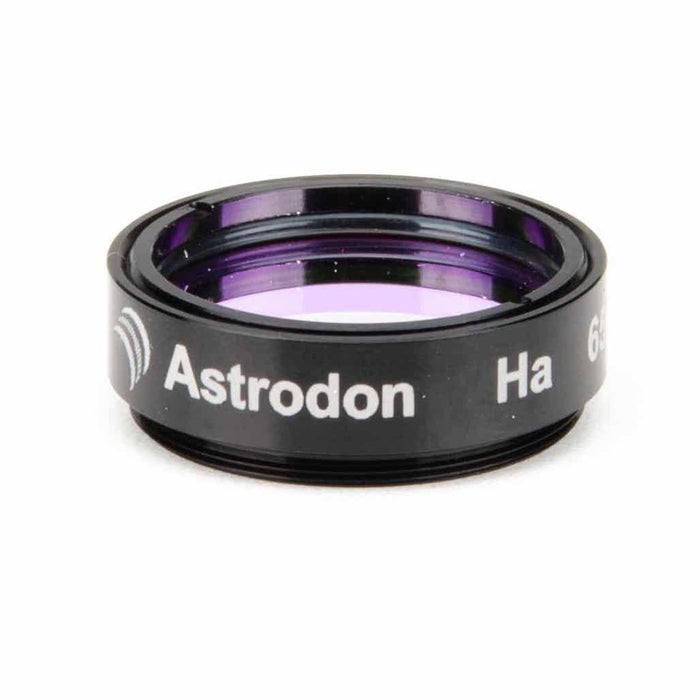
Astrodon H-alpha Filter - 5nm
Description
International Shipping

International Shipping
H-α (hydrogen-alpha) at 656 nm (nanometers) is deep red in color and the most popular narrowband filter. Hydrogen is ubiquitous in the cosmos and is present in emission nebula (North American, Pelican), planetary nebula (Dumbbell, Ring), Wolf-Rayet objects (Crescent, Thor’s Helmet) and supernova remnants (Veil). Many imagers like to present just a black-and-white H-α image of an object. It is has a beauty all by itself, like an Ansel Adams photo. However, most imagers blend their H-α data into their red RGB data to enhance structural detail while maintaining a “natural” look. Therefore, the H-α filter should be your first narrowband addition to your LRGB filters. The basic imaging set of 5 filters becomes LRGBH-α.
Astrodon H-α filters have a center bandwidth of 656.3 nm.
Astrodon Narrowband filters set a new bar of performance and durability for imaging and research. The narrow 5 and 3 nm bandwidths enhance contrast of emission targets by lowering your background signal. The guaranteed >90% transmittance at the emission wavelength provides you with the highest signal available. This guaranty is expensive to manufacture for such spectrally narrow filters, but it assures you in writing on each filter box that you will get what you paid for. These two factors combine to provide you with the highest contrast available. Our latest narrowband filters are typically achieving >95-98% transmittance. Astrodon Narrowband filters are renowned for minimizing halos around bright stars, even for long exposures of 30-45 minutes typical of narrowband imaging in astrophotography. Lastly, Astrodon Narrowband filters are coated to the edge of the part and are edge blackened. This is critical to minimize stray light for a filter that blocks most light except for the narrow bandpass.
Astrodon Narrowband filters for imaging are all about contrast. What do we mean by this? Contrast brings out faint features by reducing the background – the narrower the filter, the better. The problem is keeping the signal (%T at the emission line) constant as the filter becomes spectrally narrower. This is why our >90%T guarantee is so important, even though it becomes very costly to manufacture. But, this assures you that you can take advantage of the improved contrast with our narrower filters compared to the much less expensive 7- 8.5 nm filters on the market. You can see the increase in contrast in the sequence of equal-exposure images of the Crescent Nebula (NGC 6888) taken on the same system and on the same night. As the bandwidth becomes narrower, the nebula “pops” out of the background, as does the faint surrounding nebulosity. Actually, the >90%T is a legacy specification, since new production technologies employed over the past 3-4 years routinely produces 97-98%T at the emission wavelengths.
Random tests of a competitor’s low-cost 7 nm H-a filter showed %T values ranging from 86% down to 71%. Random selection of 5 nm Astrodon filters measured %T values at the H-a emission wavelength of 93, 98, 97 and 98%. You will never know that you are using their 71% filter compared to a 97% Astrodon filter because they do not guarantee this important performance parameter. They recently came out with a 3.5 nm H-a narrowband filter and those results are even worse, ranging from 3-70% at the emission wavelength. Similarly, analysis of different 2016 lots of Astrodon 3 nm H-a filters measured 97, 97, 97 and 96%T. Yes, our filters are more expensive, but you always know what you are getting with Astrodon Narrowband filters – the best performance in the market – guaranteed. Our recent blueshift data show that Astrodon 3 and 5 nm filters can be used with nearly all systems as fast as f/3.5 with virtually no loss in emission signal, so you do not need to buy custom “upshifted” filters if you have both fast and slow systems.
Step up to the quality and performance of Astrodon narrowband filters.